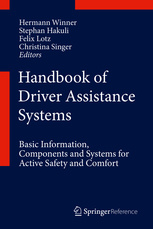Description
Handbook of Driver Assistance Systems, 1st ed. 2016
Basic Information, Components and Systems for Active Safety and Comfort
Coordinators: Winner Hermann, Hakuli Stephan, Lotz Felix, Singer Christina
Language: English
Subject for Handbook of Driver Assistance Systems:
Publication date: 03-2016
1602 p.
Publication date: 11-2015
1602 p. · 15.5x23.5 cm · Hardback
Description
/li>Contents
/li>Biography
/li>Comment
/li>
The book aims at giving a complete picture focusing on the entire system. First, it describes the components which are necessary for assistance systems, such as sensors, actuators, mechatronic subsystems, and control elements. Then, it explains key features for the user-friendly design of human-machine interfaces between driver and assistance system. Finally, important characteristic features of driver assistance systems for particular vehicles are presented: Systems for commercial vehicles and motorcycles.
Hermann Winner began working at Robert Bosch GmbH in 1987, after receiving his Ph.D. in physics, focusing on the predevelopment of “by-wire” technology and Adaptive Cruise Control (ACC). Beginning in 1995, he led the series development of ACC up to the start of production. Since 2002, he has been pursuing the research of driver assistance systems engineering topics as professor of Automotive Engineering at the Technische Universität Darmstadt.
After finishing his studies in physics, Stephan Hakuli developed driving functions for highly automated vehicles as a research associate at the Institute of Automotive Engineering (FZD) at the Technische Universität Darmstadt. Today, he works as product manager and subject specialist for driver assistance systems at IPG Automotive GmbH.
Felix Lotz studied Mechanical Engineering at Technische Universität Darmstadt. He now works as a scientific assistant at the Institute of Automotive Engineering of Technische Universität Darmstadt and focuses on research in the fields of system architectures and behavior planning of automated vehicles.
Christina Singer studied Mechanical Engineering at Fachhochschule Südwestfalen, Technische Universität Darmstadt, and Virginia Polytechnic Institute and State University. Since 2011, she has been working as scientific assistant at the Institute of Automotive Engineering at Technische Universität Darmstadt, where her research is focused on effort-reduced application and
release concepts for brakesystem controllers.



